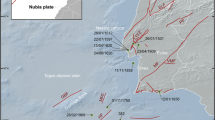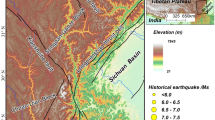Abstract
A swarm of 57 landslides, tension cracks and a rockfall occurred spontaneously on September 5, 1995 killing 3 people and destroying farmlands and forests over an area of 6 k across, at Bafaka, Ndian Division, Cameroon. From analyses of field observations, eyewitness accounts, rainfall data, and soils, the principal causative factors of the disaster are interpreted as meteorological, hydrogeological, and tectonic in origin. High and continuous rainfall which lasted for 3 days prior to the event might have saturated both sedimentary shaly sandstones of Cretaceous Period, and weathered basaltic trachytes of Tertiary Period which are prone to sliding and which lie unconformably on Precambrian gneisses and migmatites. A mapped distribution of the landslides showed their concentration along two deeply incised river valleys which are probably fault zones running in a northwest-southeast direction. This is antithetic to the direction of faults in the area which are predominantly parallel to the northeast-southwest direction of the Cameroon Volcanic Line. A felt earthquake with an estimated intensity of about IV on the Mercalli Intensity Scale must have triggered the landslides, some tension cracks, and the rockfall in the already saturated sedimentary and volcanic rocks, with larger landslides observed around the possible epicenter of the earthquake. The rockfall, from a cliff of basalt, occurred simultaneously with the landslides and this is used to further confirm a tectonic force as a probable trigger to the disaster. The tension cracks which have remained unchanged in shape three years after the disaster are interpreted as aborted landslides. Although disasters of such magnitudes are rare in this volcanic area which has been considered to be dormant, the Cameroon Volcanic Line in general is still tectonically and volcanically active. This is evidenced by the last eruption of Mount Cameroon in 1982 situated about 45 kilometers southwest of the study area, the seismically activated landslide along the Santa Graben in 1982, the Tibati fault displacement with associated seismicity in 1986, and the carbon dioxide gas explosions from Lake Monoun in 1984 and lake Nyos in 1986 which killed 37 and 1746 people respectively.
Similar content being viewed by others
References
Akwa, M. A.: 1997, Landslides kill 3, destroy cocoa farms, Cameroon Tribune No. 5990, 6 December 1995, p. 10.
Byers, A. C., III: 1992, Soil loss and sediment transport during the storms and landslides of May 1988 in Ruhengeri Prefecture, Rwanda, Natural Hazards 5, 279–292.
Dumort, J. C.: 1968, Notice Explicative Sur la Feuille Douala-Ouest. 1/500.000. Direction des Mines et de la Geologie du Cameroun, Cameroon.
Hadley, J. B.: 1978, Madison canyon rockslide, Montana, U.S.A., In B. Voight (ed.), Rockslides and Avalanches 1: Natural Phenomenon, Elsevier Scientific Publishing Company, NW., U.S.A., pp. 167–180.
Lambi, C. M.: 1989, The dynamic landscape around Akum and Santa (Bamenda Highland Region): Landslides, Revue de Geographic du Cameroun VIII(1), 65–78.
Lambi, C. M.: 1991, Human interference and environmental instability: The case of the Limbe landslide, Vol. 1, No. 1, Cameroon Geography Review, The University of Yaounde, pp. 44–52.
Nnange, J. M.: 1987, A macroseismic study of the Tibati earthquake of January 26, 1987, Report Institute of Geological and Mining Research, Yaounde, Cameroon.
Okagbue, C. O.: 1992, An appraisal of landslides in Southern Nigeria, In S. J. Freeth, C. O. Ofoegbu, and K. M. Onuoha (eds), Natural Hazards in West and Central Africa, Vieweg, Germany, pp. 137–147.
Author information
Authors and Affiliations
Rights and permissions
About this article
Cite this article
Ayonghe, S.N., Mafany, G.T., Ntasin, E. et al. Seismically Activated Swarm of Landslides, Tension Cracks, and a Rockfall after Heavy Rainfall in Bafaka, Cameroon. Natural Hazards 19, 13–27 (1999). https://doi.org/10.1023/A:1008041205256
Issue Date:
DOI: https://doi.org/10.1023/A:1008041205256




